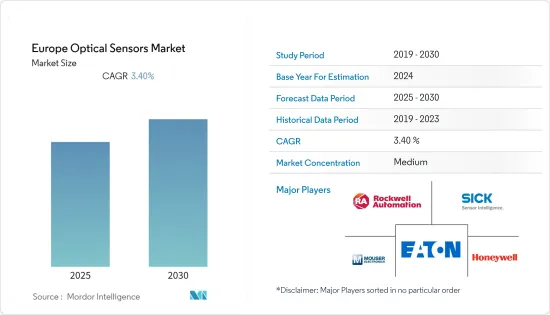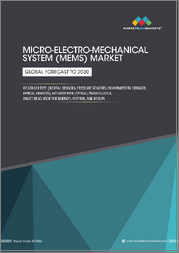
|
시장보고서
상품코드
1626898
유럽의 광학 센서 : 시장 점유율 분석, 산업 동향 및 통계, 성장 예측(2025-2030년)Europe Optical Sensors - Market Share Analysis, Industry Trends & Statistics, Growth Forecasts (2025 - 2030) |
||||||
■ 보고서에 따라 최신 정보로 업데이트하여 보내드립니다. 배송일정은 문의해 주시기 바랍니다.
유럽의 광학 센서 시장은 예측 기간 동안 CAGR 3.4%를 기록할 것으로 예상됩니다.

주요 하이라이트
- 또한, 스마트폰의 고급 보안 기능에 대한 수요 증가로 지문을 감지하고 확인하는 광학 센서인 온스크린 지문 스캔과 같은 기능이 광섬유 센서 시장을 주도하고 있습니다.
- 환경 센서는 실내의 밝기를 측정하고 그에 따라 화면의 밝기를 조절합니다. 따라서 스마트폰의 수요 증가가 이러한 센서의 수요를 견인할 것으로 예상됩니다.
- 또한, 광학 센서는 빠르고 정확한 측정이 가능하기 때문에 제조업체가 전력, 시간 및 비용을 절약할 수 있는 필수적인 도구가 되었습니다. 또한, 지능형 조명에 적용되어 수동으로 켜고 끄는 스위치에 의존하지 않고, 조명이 자연광에 따라 조명을 켜기 때문에 절전에도 도움이 됩니다.
- 화질과 가격의 불균형으로 인해 경쟁이 심화되고 있으며, 특히 가정용 전자 제품 분야에서 일부 대기업은 최적의 가격 책정에 대한 동종업계의 압력에 직면해 있습니다. 또한 일부 소규모 업체들은 제품 차별화에 어려움을 겪고 있으며, 이는 대량 생산 애플리케이션에 진입하는 데 있어 잠재적인 장벽이 되고 있습니다. 이 경우, 제품 차별화에 성공하면 제품을 순수 가격 결정 요인에서 비가격 결정 요인으로 전환할 수 있습니다.
- 따라서 각 업체들은 센서를 최소화하고 우수한 성능을 발휘할 수 있는 고도의 효율적인 기술에 집중함으로써 이 문제를 극복하고자 노력하고 있습니다. 자동화(이동 로봇)와 같은 비전통적인 분야에서 이러한 센서의 채택이 증가하고 있으며, 이 문제를 극복할 수 있을 것으로 기대됩니다.
- COVID-19는 반도체 부문에 심각한 영향을 미쳐 광학 센서 산업의 수요를 억제하고 있습니다. 반도체산업협회에 따르면 COVID-19 사태로 인한 국제 공급망 활동의 심각한 혼란으로 2020년 1분기 반도체 매출은 3.6% 감소했습니다. 또한 일부 주요 자동차 및 가전제품 OEM은 정부의 다양한 봉쇄 시나리오로 인해 제조 작업을 중단하여 광학 센서 판매량이 감소했습니다.
유럽의 광학 센서 시장 동향
자동차의 광학 센서 채택이 시장을 주도할 전망
- 자동차 산업에서 광학 센서는 자율주행, 첨단 안전 시스템, 차량용 인포테인먼트(IVI) 시스템 등 여러 카메라 지원 시스템에서 사용되고 있습니다. 이러한 센서는 3D 제스처 인식, V2X(Vehicle-to-Everything) 통신, 실내 조명 제어 애플리케이션 등 다양한 직관적인 기능을 제공합니다.
- 독일에서는 ADAS와 자율주행차 개발이 진행되어 시장 수요가 가속화되고 있으며, BMW 그룹을 비롯한 자동차 업계 주요 기업들이 이미 완전 자율주행 모델 개발에 착수했습니다.
- 2020년 11월, 혼다는 센서 기술을 통합한 레벨3 자율주행차 양산을 발표했습니다. 자동차 OEM의 유사한 노력은 시장 확대의 기회를 증가시키고 있습니다.
환경광-근접센서 분야는 가전제품 채용 증가로 성장 전망
- 조사에 따르면 디스플레이의 백라이트는 40%만 필요한 것으로 나타났습니다. 환경광 및 근접 센서(ALS)는 휴대폰, 태블릿, PDA 등 휴대용 전자기기에 자동 조정을 통한 절전 및 백라이트 개선 솔루션을 제공하는 데 적합합니다. 최근에는 액정 TV 디스플레이용 주변광 센서가 인기를 끌고 있습니다.
- 이와 유사한 추세는 가정용 및 자동차 조명 솔루션과 같은 애플리케이션을 매료시키기 시작했습니다. 예를 들어, RGB ALS를 통해 실내 조명 제어 시스템에 피드백을 제공하여 LED 기반 조명기구의 조명 색상, 강도 및 색온도 출력을 조정하여 실내 조명을 변경할 수 있습니다.
- 또한 자동차 조명은 지능형 환경 센서를 통해 낮과 밤의 운전에 대응하고 가로등의 밝기를 반영하여 전력을 절약하고 더 나은 사용자 경험을 제공 할 수 있도록 조정할 수 있습니다.
- 광학 근접 센서는 거의 모든 스마트폰 및 터치 스크린 전자 장치에 내장되어 제스처 제어, 트리거링 및 감지 애플리케이션을 가능하게하고 산업 애플리케이션, 특히 제조 공정 라인의 생산 단위 수 결정과 같은 일부 산업 애플리케이션을 가능하게합니다. 산업 응용 프로그램, 특히 제조 공정 라인의 생산 단위 수 결정과 같은 일부 산업 응용 프로그램을 가능하게합니다.
- 팬데믹은 통신 사업자들이 5G 네트워크 구축에 어려움을 겪고 있는 가운데 큰 후퇴를 초래하고 있습니다. 동시에 팬데믹은 사람들이 재택근무를 하면서 인터넷에 대한 의존도가 높아지면서 기술에 대한 수요를 촉진하고 있습니다.
유럽의 광학 센서 산업 개요
유럽의 광학 센서 시장은 경쟁이 치열하고 여러 주요 업체들로 구성되어 있습니다. 이들 기업은 시장 점유율과 수익성을 높이기 위해 전략적 협력 이니셔티브를 활용하고 있습니다.
- 2020년 2월-China International Optoelectronic Exposition에 따르면 IRay Technology는 COVID 감염 가능성이 있는 환자의 실시간 온도 감지를 위해 광학 센서가 내장된 열화상 카메라를 제조하고 있습니다. 제조하고 있습니다. 공항, 기차역, 공장, 병원에는 이상 온도를 경보로 알려주는 이 이미저가 설치되어 있습니다.
기타 혜택:
- 엑셀 형식의 시장 예측(ME) 시트
- 3개월간의 애널리스트 지원
목차
제1장 소개
- 조사 가정과 시장 정의
- 조사 범위
제2장 조사 방법
제3장 주요 요약
제4장 시장 역학
- 시장 개요
- 시장 성장 촉진요인과 시장 성장 억제요인 소개
- 시장 성장 촉진요인
- 스마트폰 보급 확대
- 각 업계의 절전 디바이스 수요 증가
- 다양한 산업의 자동화 기술 시장 침투 증가
- 시장 성장 억제요인
- 화질과 가격 불균형
- 밸류체인/공급망 분석
- 업계의 매력 - Porter's Five Forces 분석
- 신규 참여업체의 위협
- 구매자의 교섭력
- 공급 기업의 교섭력
- 대체품의 위협
- 경쟁 기업 간의 경쟁 강도
제5장 시장 세분화
- 유형별
- 외재 광학 센서
- 내장 광학 센서
- 센서 유형별
- 광섬유 센서
- 이미지 센서
- 광전 센서
- 환경광 및 근접 센서
- 기타 센서 유형
- 용도별
- 산업용
- 의료용
- 바이오메트릭스
- 자동차
- 가전
- 기타 용도
- 국가별
- 독일
- 영국
- 프랑스
- 기타 유럽
제6장 경쟁 구도
- 기업 개요
- Mouser Electronics
- SICK AG
- Rockwell Automation
- Honeywell
- Eaton
- Turck
- Bosch
- Atmel
- STMicroelectronics
- Hitachi
- Omnvision
제7장 투자 분석
제8장 시장 전망
ksm 25.01.16The Europe Optical Sensors Market is expected to register a CAGR of 3.4% during the forecast period.

Key Highlights
- Also, the increasing demand for advanced security features in smartphones has led to features, such as on-screen fingerprint scan, an optical sensor that detects and verifies fingerprints, driving the fiber optic sensor market.
- Ambient sensors measure the light in the room and adjust the screen's brightness accordingly. Thus, the increasing demand for smartphones is expected to drive the demand for these sensors.
- Optical sensors are also becoming an indispensable tool for manufacturers to save power, time, and money, because of the rapid and precise measurements they provide. Moreover, as these sensors have applications in intelligent lighting, they help save power, as they do not rely on a manual on-off switch but turn on light according to the natural light in the premises.
- The imbalance between image quality and price has led to increased competition, particularly for the consumer electronics segment, which has some of the most established players facing peer pressure over optimal pricing. Several small players are also facing difficulty over product differentiation, which leads to a potential barrier for their entry into high-volume applications. In this case, successful product differentiation can move a product from pure pricing to non-pricing factors.
- Thus, companies are vying to overcome this challenge by focusing on advanced and efficient technologies that would help minimize sensors and superior performance. The increasing adoption of these sensors in non-traditional fields, such as automation (mobile robots), is expected to overcome this challenge.
- The COVID-19 pandemic has seriously impacted the semiconductor sector, curbing demand in the optical sensor industry. According to the Semiconductor Industry Association, semiconductor sales in the first quarter of 2020 fell 3.6% due to the severe disruption of international supply chain activities due to the COVID-19 pandemic. In addition, some major automotive and consumer electronics OEMs have shut down manufacturing operations due to various government blockade scenarios, resulting in lower sales of optical sensors.
Europe Optical Sensors Market Trends
Adoption of opical sensors in automobiles is expected to drive the market
- In the automotive industry, optical sensors are used in several camera-enabled systems, including autonomous driving, advanced safety systems, and in-vehicle infotainment (IVI) systems. These sensors provide a variety of intuitive features such as 3D gesture recognition, Vehicle-to-Everything (V2X) communication, and indoor lighting control applications.
- The growing development of ADAS and self-driving cars in Germany will accelerate market demand. Leading companies in the automotive industry, such as the BMW Group, have already begun developing fully autonomous models.
- In November 2020, Honda announced mass production of Level 3 self-driving cars with integrated sensor technology. Similar initiatives by automotive OEMs add opportunities for expansion to the market.
The ambient light and proximity sensor segment is expected to grow due to increase adoption of consumer electronics
- According to research, backlighting for displays is only required 40% of the time. Ambient light and proximity sensors (ALSs) have been suitable in offering power saving through automatic adjustment and improved backlighting solutions for hand-held electronic devices such as mobile phones, tablets, PDA's, among others. Recently ambient sensors for LCD TV displays have gained traction.
- A similar trend has started to attract applications such as home and automotive lighting solutions. For instance, the room's illumination can be changed through RGB ALSs that provide feedback to a room's lighting-control system to adjust the light color, intensity, and color temperature output of the LED-based luminaires.
- Also, automobile lighting can be adjusted to accommodate day or night driving or reflect the brightness of streetlights through intelligent ambient sensors that offer saving power and provide a better user experience.
- Optical proximity sensors have been integrated into almost every smartphone and touch-screen electronic device to enable gesture control, trigger and detection applications, and some industrial applications such as determining the number of production units in industrial applications, particularly in manufacturing process lines.
- The pandemic has caused significant setbacks as carriers struggle to deploy 5G networks. At the same time, pandemics are driving the demand for technology as people become more and more dependent on the Internet while working from home.
Europe Optical Sensors Industry Overview
The Europe optical sensors market is competitive and consists of several major players. These companies are leveraging strategic collaborative initiatives to increase their market shares and profitability.
- February 2020 - China International Optoelectronic Exposition reports that IRay Technology is manufacturing thermal imagers that incorporate optical sensors for real-time temperature detection of potential COVID-infected patients. Airports, train stations, factories, and hospitals are equipped with this imager that alerts to abnormal temperatures with alarms.
Additional Benefits:
- The market estimate (ME) sheet in Excel format
- 3 months of analyst support
TABLE OF CONTENTS
1 INTRODUCTION
- 1.1 Study Assumptions and Market Definition
- 1.2 Scope of the Study
2 RESEARCH METHODOLOGY
3 EXECUTIVE SUMMARY
4 MARKET DYNAMICS
- 4.1 Market Overview
- 4.2 Introduction to Market Drivers and Restraints
- 4.3 Market Drivers
- 4.3.1 Increasing Market Penetration of Smartphones
- 4.3.2 Increasing Demand for Power-saving Devices Across Industries
- 4.3.3 Increasing Market Penetration of Automation Techniques Across Various Industries
- 4.4 Market Restraints
- 4.4.1 Imbalance Between the Image Quality and Price
- 4.5 Value Chain / Supply Chain Analysis
- 4.6 Industry Attractiveness - Porter's Five Forces Analysis
- 4.6.1 Threat of New Entrants
- 4.6.2 Bargaining Power of Buyers
- 4.6.3 Bargaining Power of Suppliers
- 4.6.4 Threat of Substitute Products
- 4.6.5 Intensity of Competitive Rivalry
5 MARKET SEGMENTATION
- 5.1 By Type
- 5.1.1 Extrinsic Optical Sensor
- 5.1.2 Intrinsic Optical Sensor
- 5.2 By Sensor Type
- 5.2.1 Fiber Optic Sensor
- 5.2.2 Image Sensor
- 5.2.3 Photoelectric Sensor
- 5.2.4 Ambient Light and Proximity Sensor
- 5.2.5 Other Sensor Types
- 5.3 By Application
- 5.3.1 Industrial
- 5.3.2 Medical
- 5.3.3 Biometric
- 5.3.4 Automotive
- 5.3.5 Consumer Electronics
- 5.3.6 Other Applications
- 5.4 By Country
- 5.4.1 Germany
- 5.4.2 United Kingdom
- 5.4.3 France
- 5.4.4 Rest of Europe
6 COMPETITIVE LANDSCAPE
- 6.1 Company Profiles
- 6.1.1 Mouser Electronics
- 6.1.2 SICK AG
- 6.1.3 Rockwell Automation
- 6.1.4 Honeywell
- 6.1.5 Eaton
- 6.1.6 Turck
- 6.1.7 Bosch
- 6.1.8 Atmel
- 6.1.9 STMicroelectronics
- 6.1.10 Hitachi
- 6.1.11 Omnvision
7 INVESTMENT ANALYSIS
8 FUTURE OF THE MARKET
샘플 요청 목록



















